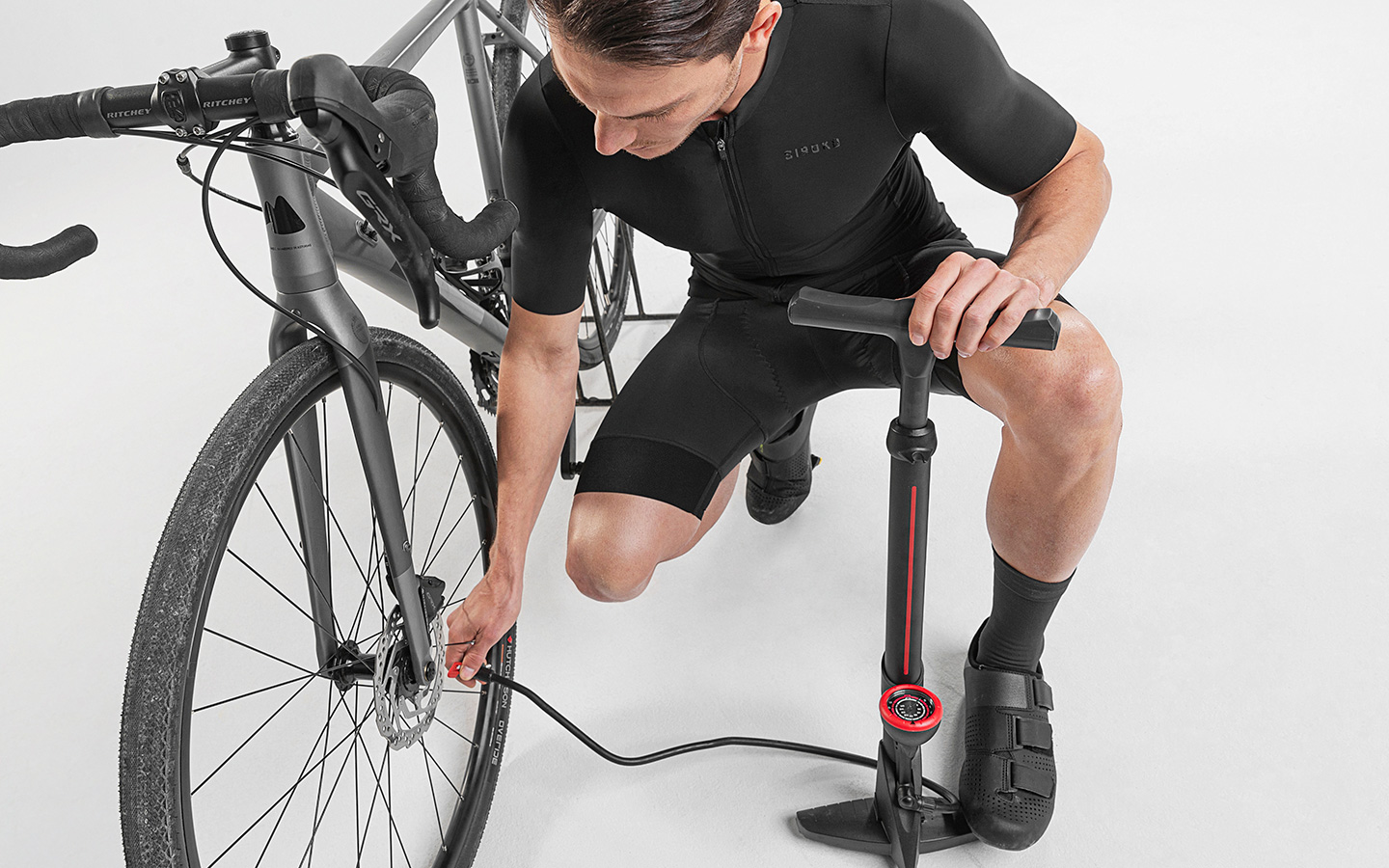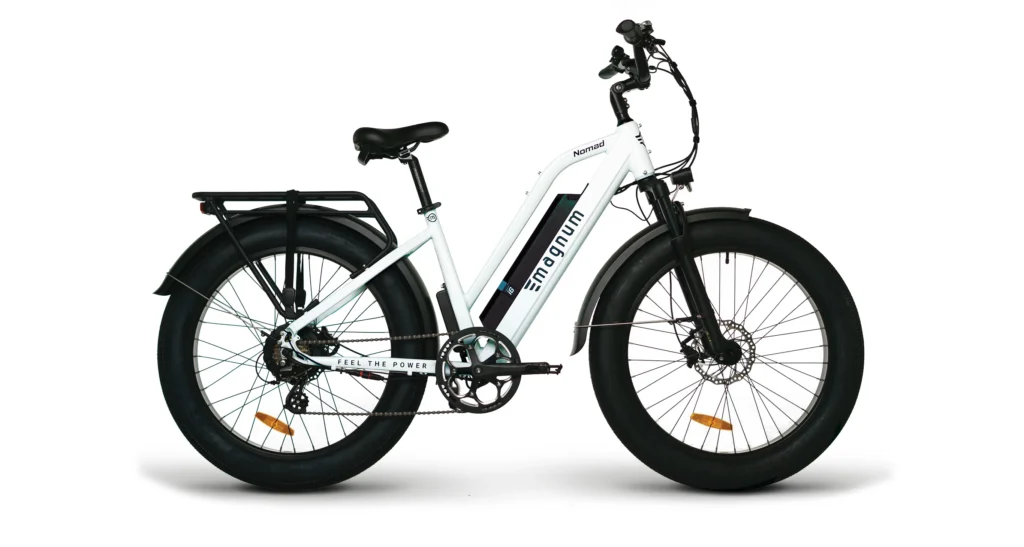
What Is the Right Tire Pressure
The most common answer is, “I just squeeze the tire.” It would be better to use a pressure gauge. Look on the side of your tire and inflate it to no more than the recommended pressure. Too much air could cause a blowout. More than 10% of the maximum is probably too much.
If you are looking for comfort, use a little less air. If you want better rolling efficiency to carry your speed, go a little higher. Some tires have a range listed. It’s best not to go lower than this. However, if nothing is listed, 20% under the upper limit is probably as low as you should go. You do run a risk of pinch flats when the pressure is too low, and it’s harder to pedal at lower pressures. No matter, the recommended pressure is on the sidewall.
Tires lose air every day. It’s best to add air at least once a week. If the tire goes flat, sitting on the ground will cause a crack at the folded part, leading to a possible blowout. Low pressure will let the tire slip around, possibly tearing the valve stem. Low pressure will also make rim damage easier because the tire cannot absorb the impact as well. Slow leaks and punctures are no fun. If your tire continually loses all its air, you might consider some flat protection.
Tubeless tires will run at a lower pressure than tubedtires. Mountain bike tires, especially Plus tires, will run quite low. The sidewall rating will typically account for lower pressures used without a tube. Plus-size tires may be run as low as 12psi, and fat tires even lower (more on that later). Don’t forget that tubeless tire setups lose air faster, and the sealant must be refreshed at least every few months to keep it working.
If you have a street e-bike, you will want to run at the maximum tire pressure. This helps protect the rim from damage and extends the battery range. E-MTBs can run at regular MTB pressures, but you will sacrifice battery distance.
Either way, keep your tires up to your selected rating. Many riders check their pressure before every ride. This ensures if you have a slow leak, you’ll notice it sooner too.
As a guide, here is a list of typical tire pressures, however, consult your owner’s manual or tire sidewall for the safe high and low pressure limits. But in general, lower the tire air volume (skinny tires) equates to higher operating pressures. Some riders put 2-4 psi less in the front tire for better corner traction. Some typical or common ranges are:
700X20 to 700X28 run around 100psi to 120psi, tubeless setups 80psi to 95psi.
29X2.2 to 29X2.8 run about 30psi to 38psi, tubeless setups 18psi to 26psi.
27.5X2.2 to 27.5X3.0 run best at a little less than a 29er, about 28psi to 35psi, tubeless setups 16psi to 24psi.
26X1.5 to 26X1.95 mountain bike tires that are used mainly on the street or mild trails: 30-45psi.

Fat-Tire Bikes
20X4.0 and 26X4.0 to 26X5.0 run far lower pressure, especially in sand or snow. Typical ranges are 12psi to 20psi. Not to be confused with Plus-size tires, Fat tires generally start at 4 inches in cross-section. That’s a big tire. Found most commonly in 20-inch and 26-inch wheel sizes, 4-inch Fat tires are becoming very common. Some bikes have even come equipped with tires as large as 5 inches and as small as 3.8 inches. (Smaller size tires, like 2.6 to 2.8 inches, are usually called “Plus Size”).
The main objective of a Fat tire is to float over the terrain, be it sand, snow, grass, or gravel. Fat tires vastly improve handling and ride comfort over smaller-profile tires. With a Fat tire, your contact patch, that is, the area where the tire connects to the ground, is quite a bit bigger, thus the float.
The more popular Fat tire bikes are those used for a recreational focus, like riding at the beach, in the park, or down a graded dirt path. Speeds are reduced with a Fat tire because the tire gives more rolling resistance as the wheel turns. Steering is also more relaxed, making the bike less nimble. In exchange, you get increased comfort and great low-speed control, especially in loose terrain. There are Fat tire bikes made for novice and expert riders. High-end Fat tire bikes are lighter and more agile and, as you would expect, cost more. Snow riding is a widespread endeavor with a sporty Fat tire bike. Electric models are popular in this segment too. Fat bikes start at about $600 and go as high as $6,000.
Tire pressure is the single most important adjustment you need to make to your Fat tire bike. In order to operate correctly and handle properly, your tire pressure must be set for the conditions, your riding style, weight, and the type of bike you have. Do consult your manufacturer’s operation manual and look at the sidewall of the tire for pressure recommendations. Expect to experiment with different settings. It is surprising how much difference just a few pounds of air pressure can make.
Use a low-pressure tire gauge to check inflation. It is very easy to overinflate your tire, especially when using an air compressor. Since you will use very low pressures, find a gauge that can read down to just a few pounds. Many Fat tires are rated at no more than 20 PSI. When overinflated, you risk blowing the tire out, but more so, a ride that feels like you are on a beach ball.
Since the innertube holds the air, very low pressure could cause the tire to pinch over sharp obstacles, resulting in a flat tire. As you get better at riding, you can experiment with lower pressure, becoming more competent at gliding over rocks, potholes, or sharp edges. Be prepared. If you experience a puncture, ensure you have a spare tube, some tools, and a way to add air to the tire.
Many riders consider some sort of flat protection. Be it Slime, tire liners, or Tannus inserts, being prepared is always a good idea. Punctures are inevitable. No one is immune from a flat tire. It could be a year or a day from now. So, take a few precautions before you set out on your ride.

Determining your tire pressure is related to where you plan to ride. E-bikes and heavier riders should use higher pressures. Smaller tires should have more air than larger tires. 20-inch tires run about 5psi more than a similar sized 26-inch tire. Generally, these are the most common conditions and associated pressures for a 26-inch X 4.0 tire:
- Soft Conditions – 8 PSI to 12 PSI. Sounds crazy, but fresh snow can be navigated at as low as 5 PSI, depending on the tire bead. Sand is handled best at about 10 PSI.
- Trail Riding – 12 PSI to 18 PSI. This is where most riders take their bikes. These are groomed and maintained, multi-use, trails and bike paths.
- Varied Terrain – 15 PSI to 20 PSI. You would expect sharp edges, rocks, and other unexpected challenges on these trails. More experienced riders will go with lower pressures.
- Pavement – 18 PSI to 22 PSI. These are hard surfaces where you would expect a faster pace. Bikes that are made for this riding will come equipped with a smooth tread tire, for faster rolling.
Too much pressure results in a bouncy ride. The tire loses contact with the ground when is bounces, and makes handling difficult. The goal is to float over the ground, maintaining contact with the surface, for optimal traction. Also, there are tires made with studs for icy conditions. In the winter, a studded tire could add a lot of excitement to your ride. Talk with other riders. Ask what pressure they are running. Tribal knowledge can be very useful. For example, many report using higher pressure when they have Tannus Armour tire protection installed.
Copyright Randy Archer 2024
